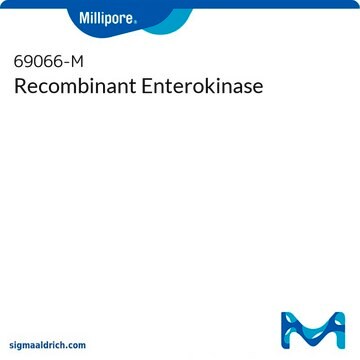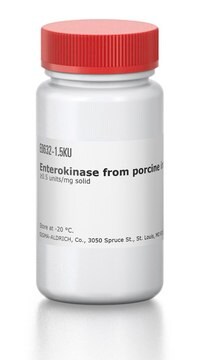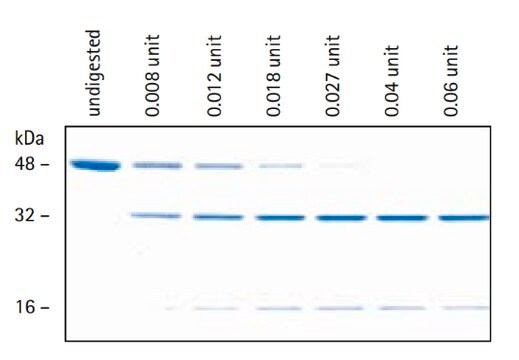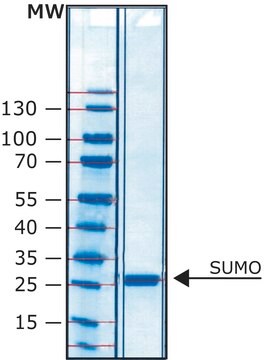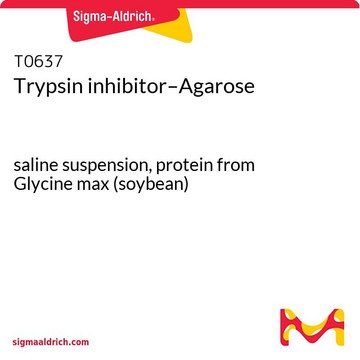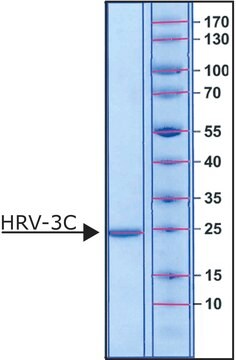Allgemeine Beschreibung
Human Enterokinase is expressed as a linear 1019 amino acid polypeptide precursor glycoprotein. Proteolytic processing of this precursor generates the biologically active form of enterokinase, which consists of two polypeptide chains (heavy chain and light chain) held together by a single disulfide bond, resulting in formation of a biologically active heterodimer. The heavy chain consists of 784 amino acid residues, and the light consists of 235 amino acid residues. The mRNA is present in the proximal small intestine, and the protein is in enterocytes of the duodenum and proximal jejunum. The gene is mapped to human chromosome 21q21.
Biochem./physiol. Wirkung
Proteases (also called proteolytic enzymes, peptidases, or proteinases) are enzymes that hydrolyze the amide bonds within proteins or peptides. Most proteases act in a specific manner, hydrolyzing bonds at or adjacent to specific residues or a specific sequence of residues contained within the substrate protein or peptide. Proteases play an important role in most diseases and biological processes including prenatal and postnatal development, reproduction, signal transduction, the immune response, various autoimmune and degenerative diseases, and cancer. Enterokinase sequentially cleaves carboxyl side of D-D-D-D-K. It is a serine protease which mainly activates trypsinogen.
Sequenz
Heavy chain: LTIKESQRGA ALGQSHEARA TFKITSGVTY NPNLQDKLSV DFKVLAFDLQ QMIDEIFLSS NLKNEYKNSR VLQFENGSII VVFDLFFAQW VSDQNVKEEL IQGLEANKSS QLVTFHIDLN SVDILDKLTT TSHLATPGNV SIECLPGSSP CTDALTCIKA DLFCDGEVNC PDGSDEDNKM CATVCDGRFL LTGSSGSFQA THYPKPSETS VVCQWIIRVN QGLSIKLSFD DFNTYYTDIL DIYEGVGSSK ILRASIWETN PGTIRIFSNQ VTATFLIESD ESDYVGFNAT YTAFNSSELN NYEKINCNFE DGFCFWVQDL NDDNEWERIQ GSTFSPFTGP NFDHTFGNAS GFYISTPTGP GGRQERVGLL SLPLDPTLEP ACLSFWYHMY GENVHKLSIN ISNDQNMEKT VFQKEGNYGD NWNYGQVTLN ETVKFKVAFN AFKNKILSDI ALDDISLTYG ICNGSLYPEP TLVPTPPPEL PTDCGGPFEL WEPNTTFSST NFPNSYPNLA FCVWILNAQK GKNIQLHFQE FDLENINDVV EIRDGEEADS LLLAVYTGPG PVKDVFSTTN RMTVLLITND VLARGGFKAN FTTGYHLGIP EPCKADHFQC KNGECVPLVN LCDGHLHCED GSDEADCVRF FNGTTNNNGL VRFRIQSIWH TACAENWTTQ ISNDVCQLLG LGSGNSSKPI FSTDGGPFVK LNTAPDGHLI LTPSQQCLQD SLIRLQCNHK SCGKKLAAQD ITPK Light Chain: IVGGSNAKEG AWPWVVGLYY GGRLLCGASL VSSDWLVSAA HCVYGRNLEP SKWTAILGLH MKSNLTSPQT VPRLIDEIVI NPHYNRRRKD NDIAMMHLEF KVNYTDYIQP ICLPEENQVF PPGRNCSIAG WGTVVYQGTT ANILQEADVP LLSNERCQQQ MPEYNITENM ICAGYEEGGI DSCQGDSGGP LMCQENNRWF LAGVTSFGYK CALPNRPGVY ARVSRFTEWI QSFLH
Physikalische Form
Lyophilized from 10 mM Sodium Phosphate, pH 7.5 + 1 mM Calcium Chloride.
Rekonstituierung
Centrifuge the vial prior to opening. Reconstitute in water to a concentration of 0.1-1.0 mg/ml. Do not vortex. This solution can be stored at 2-8°C for up to 1 week. For extended storage, it is recommended to store in working aliquots at -20°C to -80°C.
